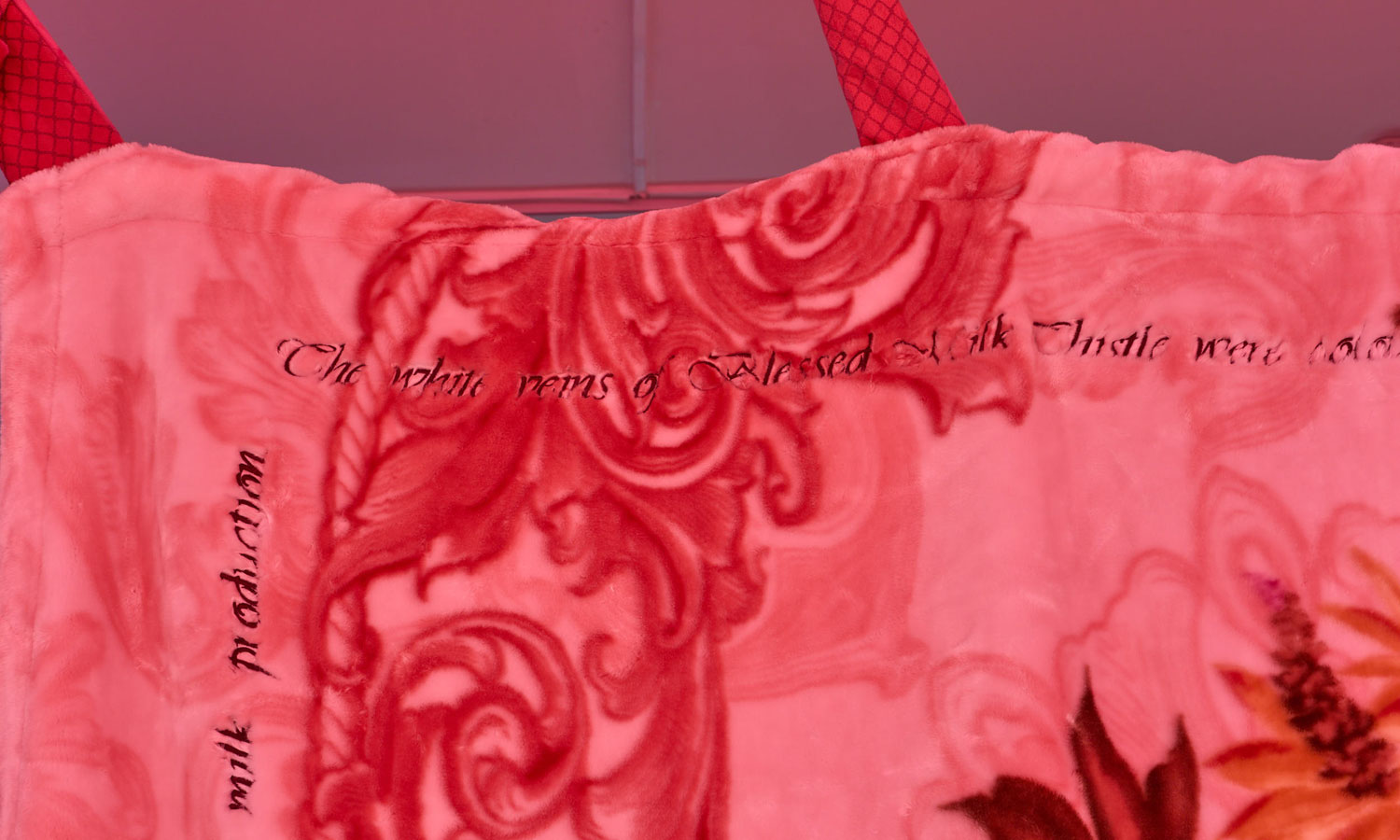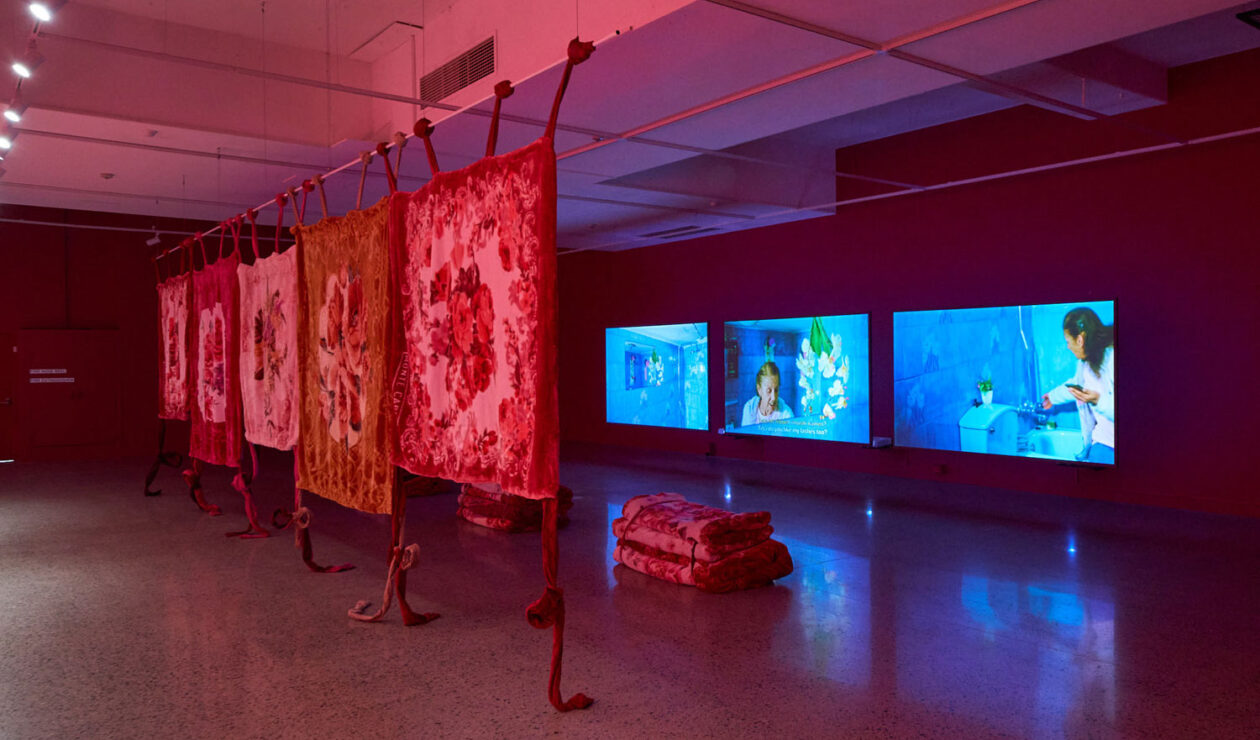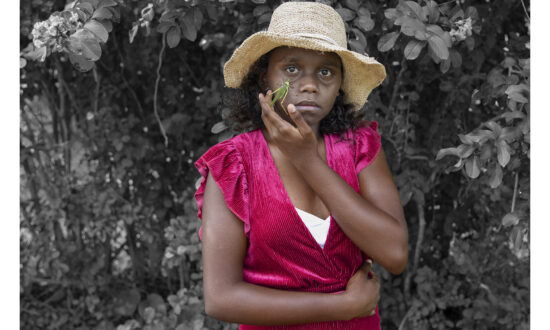Justine Youssef, Somewhat Eternal
Adelaide Contemporary Experimental
Adelaide Contemporary Experimental is currently awash with a rose tint and scent that snare the senses. It is a kind of immersive experience where the audience does not necessarily require knowledge of art or art history, or even to possess much cultural interest to be affected.
Although the auto-ethnographic work is a personal story from Darug/Sydney-based artist Justine Youssef’s particularly nuanced experience of multiculturalism, much of the exhibition’s imagery has a relatability and a warmth to it.
Within the three video channels playing simultaneously (a display technique that is rooted in the 1966 split-screen film Chelsea Girls by Andy Warhol and Paul Morrissey) there are domestic soft cuddly toys, food, bedding, maternal figures, and turned-up warm tonal hues of moving imagery that hark back to 1970s family photography – all of which provide visceral resonance and connection with memory.
Youssef’s installation is essentially a deconstructed living room, its “walls” demarcated with large velveteen blankets of the kind common throughout the eastern Mediterranean region known as Levant. The five blankets are embroidered with a text by the artist that is replicated in pale rose lettering along the length of the gallery’s east wall; they are also strung with trinkets and charms and imbued with a variety of plant-based scents.

Large velveteen blankets in Justine Youssef’s Somewhat Eternal are embroidered with text. Photo: Sam Roberts
Facing the blankets is the three-channel video installation, shot in Lebanon, featuring the artist’s maternal aunt performing a protective blessing (R’sasa) to clear the evil eye. (The exhibition notes explain that the lead used in R’sasa is often extracted from bullets still found in the region from the time when parts of Lebanon were under Israeli occupation from 1982 to 2000.) Between the videos are soft seats fashioned from more folded blankets from which to view the work.
Adelaide Contemporary Experimental’s towering walls have been painted dark magenta pink – a heavily referential, some would say queer-coded hue – for the occasion. Combined with the almost excessive hyper-femininity of the sensory assault, it’s like being inside a giant womb – or at the very least, a very safe, very pink, very rose-scented place.
But under the rug, underneath all the softness and saccharine accessibility, there is a complex, nuanced story of complexity, of human trauma, struggle for survival and agency – a narrative of resilience that many First Peoples, and those undergoing occupation, can identify with. Throughout the vinyl and embroidered script, Youssef speaks to the co-existence of multiple displacements – of plants and humans and cultures and memories – and the conflicts that swirl around territories, and belongings.

An ACE installation view of Somewhat Eternal, by Justine Youssef, which encompasses video, textiles, text and scent. Photo: Sam Roberts
There is a difference between autobiography and auto-ethnography. While the latter incorporates autobiography, it is not an uncritical historical account. Auto-ethnography looks to extract meaning from experience, rather than depict experience exactly as it is lived; putting the “autobiographical and personal” in conversation with the “cultural and social”. It is the opening up of the self, of caring for the self, that decolonises, with the public display of the work allowing for discourse and learning. This is why the visual arts are regarded as legitimate research in academia.

Get InReview in your inbox – free each Saturday. Local arts and culture – covered.
Thanks for signing up to the InReview newsletter.
Youssef’s work extends her research into living rituals into a contemporary installation that mobilises the intensity of lived experiences into an immersive, multi-sensory ensemble.
Somewhat Eternal, curated by Stella Rosa McDonald, Tulleah Pearce and Patrice Sharkey, is presented by Adelaide Contemporary Experimental, UTS Gallery & Art Collection (Sydney), and the Institute of Modern Art (Brisbane). The final presentation is at ACE until October 19.
Adelaide Contemporary Experimental is also currently showing the Kaurna Women’s Art Collective’s display Sisters of Lartelare, which Troy-Anthony Baylis reviewed last week.
Support local arts journalism
Your support will help us continue the important work of InReview in publishing free professional journalism that celebrates, interrogates and amplifies arts and culture in South Australia.
Donate Here




